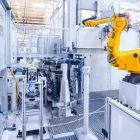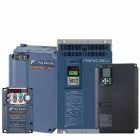The Human-Machine Interface (HMI) allows a person to interact with a machine, system, or process. It provides a visual way for operators to monitor, control, and interact with complex systems. HMIs are essential for modern industrial automation and control. Fuji Electric offers a range of HMI solutions that help streamline operations and improve efficiency. You can explore its products on the Fuji Electric website.
Key Functions of an HMI
HMIs perform several crucial functions that enhance operational efficiency:
Monitoring
HMIs display real-time data from machines and processes. This feature allows operators to track performance metrics such as temperature, pressure, and production rates at a glance. By having this information readily available, operators can make informed decisions quickly.
Control
HMIs enable operators to adjust process parameters easily through intuitive controls such as sliders, buttons, and touchscreens. This functionality allows precise control over machinery and processes, ensuring optimal performance without extensive training.
Data Acquisition
HMIs log and store data continuously from various sources. This capability provides valuable insights for analysis and reporting. Operators can review historical data trends to identify patterns or anomalies requiring attention.
Alarm Management
HMIs effectively display alarms and notifications related to critical events or system failures. This feature helps operators respond promptly to issues before escalating into more significant problems, enhancing overall safety.
User Interface
HMIs offer an intuitive way for operators to interact with complex systems. A well-designed user interface can reduce operator errors and improve response times by presenting information clearly and concisely.
Components of an HMI System
An HMI system consists of a few key components that work together seamlessly:
HMI Software
This is the brains of the operation, running on the HMI hardware. The software provides the tools for creating user interfaces, configuring alarms, and managing data logging.
HMI Hardware
This includes:
Touchscreen Panels
With these, operators can directly interact with the system through touch screens, making navigating menus and managing processes easy.
Industrial PCs
These offer robust computing power suitable for demanding environments. They can run complex software applications while maintaining reliability under harsh conditions.
Mobile Devices
These enable remote monitoring and control through smartphones or tablets. Operators can access critical information anytime and anywhere.
Communication Interfaces
These connect the HMI to PLCs, sensors, and other devices using protocols like Ethernet/IP or Modbus. Effective communication ensures seamless data exchange between systems.
Applications of HMI
HMIs have a broad range of applications across various industries:
Factory Automation
In manufacturing settings, HMIs streamline production processes by allowing operators to monitor machinery status in real time. This capability helps identify bottlenecks quickly.
Process Control
HMIs enable precise monitoring and control of processes in industries like chemicals or oil and gas. Operators can adjust variables such as flow rates or temperatures based on real-time data.
Building Automation
HMIs manage commercial buildings’ HVAC systems, lighting controls, security systems, and energy management. This integration enhances comfort while reducing energy costs.
Power Generation and Distribution
In power plants or substations, HMIs monitor equipment performance and manage power distribution networks efficiently. Operators can respond quickly to any irregularities in power flow.
Transportation Systems
HMIs oversee traffic management systems, rail operations, and airport logistics. They help ensure smooth operation by providing real-time updates on system status.
If you think about it, HMIs apply in all industries.
Benefits of Using HMI
Using HMIs can significantly improve your operations:
Improved Operator Efficiency
HMIs enhance operator productivity by simplifying monitoring and control tasks. Operators spend less time sifting through data and more time making decisions that impact performance.
Enhanced Process Visibility
With real-time insights into operations displayed clearly on screens, operators can quickly identify issues or inefficiencies that require attention.
Reduced Downtime
Alarm notifications facilitate quick responses, minimizing downtime. When alerted immediately about issues, operators can take corrective actions faster than ever.
Better Data Analysis
Continuous data logging allows for in-depth analysis over time. Operators can use this information to make decisions that improve process efficiency or product quality.
Increased Safety
HMIs help prevent accidents in hazardous environments by providing critical safety information through alarms and alerts. When operators can access relevant data, they are better equipped to handle emergencies.
Pro tip: Customize your HMI screens to display the most critical information for your process. This will reduce screen clutter and help operators focus on what matters most for efficient operations.
Considerations when Selecting an HMI
Here are some essential factors to consider when choosing an HMI:
Communication Protocols
Check which communication protocols your devices support to ensure compatibility with existing equipment. This is a crucial step to ensure smooth integration into your current system.
Screen Size and Resolution
Choose an appropriate size for the application while ensuring readability from various distances. Higher-resolution screens provide clearer visuals but may also increase costs.
Environmental Factors
When selecting hardware options, consider temperature ranges, humidity levels, dust exposure, or vibrations in your operational environment. Choosing ruggedized equipment may be necessary in harsh conditions.
Software Features
Evaluate functionality such as alarm management capabilities or data logging features based on your operational needs. User-friendly software allows operators to adapt quickly without extensive training.
Security
Implement robust cybersecurity measures within your HMI setup to protect against unauthorized access. Software updates are also essential for maintaining security integrity.
Fuji Electric HMI Products
Fuji Electric offers a range of HMI products designed to meet diverse industrial needs effectively. These include various types of HMIs equipped with key features tailored specifically for different industries, such as manufacturing or energy management. Visit the Fuji Electric website to learn more about their innovative operational efficiency solutions.
Emerging Trends in HMI Technology
The world of HMIs is constantly evolving; keep an eye on these emerging trends:
Mobile HMIs
Remote monitoring capabilities allow operators access from smartphones or tablets anytime and anywhere—ideal for teams working across multiple locations who need real-time updates without being tied down at a workstation.
Cloud-Based HMIs
These solutions enable users to access HMI data online without needing physical hardware. This allows greater flexibility in managing processes remotely while reducing infrastructure costs associated with traditional setups.
Augmented Reality (AR) HMIs
AR technology overlays real-time data onto physical environments, enhancing visualization capabilities by providing context-sensitive information related to the monitored equipment. This leads to more innovative decision-making processes overall!
Pro tip: Explore cloud-based HMI solutions to enable remote monitoring and collaboration among teams in different locations. This flexibility can be a game-changer for distributed teams that want seamless communication!
FAQs About an HMI
What is the difference between HMI and SCADA?
The HMI is the user interface that presents data from the control system (such as a PLC or SCADA system) to the operator. SCADA (Supervisory Control and Data Acquisition) is a complete control system that includes HMIs, PLCs, remote telemetry units (RTUs), and communication infrastructure. The HMI acts as a component within the broader SCADA framework.
What is the difference between an HMI and a display?
A display is a generic term for any screen that shows information; however, an HMI is a specific type of display designed explicitly for industrial control applications. Unlike standard displays in consumer electronics, HMIs are typically more ruggedized and have specialized communication capabilities tailored to industrial environments (e.g., alarm management features).
Which is better: SCADA or PLC?
They serve different purposes; therefore, one isn’t inherently “better.” A PLC (Programmable Logic Controller) is a real-time control device that directly manages machines and processes. At the same time, SCADA serves as a supervisory system that monitors and controls larger areas involving multiple PLCs and other devices. These often form foundational layers upon which SCADA systems build their functionalities!
Can I use an HMI without a PLC?
It depends on application requirements, but generally speaking, no! The most commonly used scenarios involve visualizing and interacting with data sourced from PLCs and other control systems. Without them providing necessary input signals, the functionality would be severely limited! However, in some niche cases where direct sensor connections exist, this remains less common overall!
Can a PC be used as an HMI?
Yes! Industrial PCs (IPCs) frequently serve as effective platforms for hosting various software applications designed specifically for human-machine interactions. Compatible software is installed on these devices connected directly to existing control networks. Users have full access via monitors, keyboards, mice, and touchscreens.
HMIs are essential for modern industrial operations since they enhance efficiency while improving visibility and safety standards across workplaces everywhere! As technology continues its rapid advancement trajectory, HMIs will evolve further, offering even more powerful tools that empower operators and engineers alike.
About Fuji Electric Sales Philippines, Inc.
Fuji Electric Sales Philippines, Inc., a subsidiary of Japan’s Fuji Electric Co., Ltd., works to bring reliable energy and automation solutions to the Philippines. The company provides sales, promotion, and support for technologies that help develop industries and improve power systems.
Improve your systems with HMI! Reach out to Fuji Electric via:
Harold Alvarez
Sales Engineer
0917-825 8293








